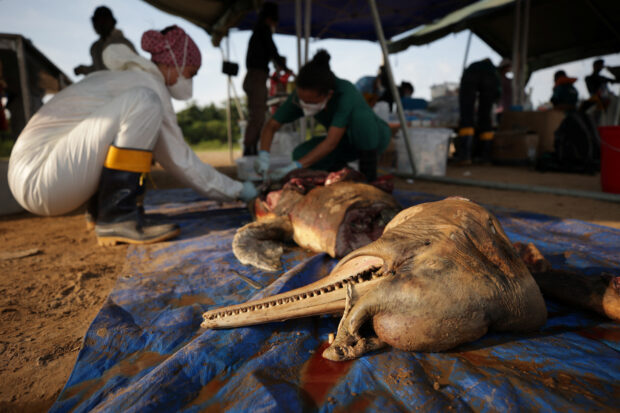
FILE PHOTO: Researchers from the Mamiraua Institute for Sustainable Development analyze a dead dolphin at the Tefe lake affluent of the Solimoes river that has been affected by the high temperatures and drought in Tefe, Amazonas state, Brazil, October 1, 2023. REUTERS/Bruno Kelly/File photo
MANAUS — A startling discovery has been made in the Amazon River tributary as the carcasses of 120 river dolphins have been found floating since last week. Experts believe that severe drought and heat may be the cause of this phenomenon.
According to researchers, the dolphins have been unable to survive the high temperatures caused by low river levels during the severe drought. The extreme heat has made the water intolerable for them, resulting in their deaths. Additionally, thousands of fish in the Amazon rivers have died recently due to a lack of oxygen in the water.
The river dolphins found in the Amazon, many of which have a striking pink color, are a unique freshwater species endemic to South America. They are one of the few remaining freshwater dolphin species in the world. Their slow reproductive cycles make them highly susceptible to threats.
While the exact cause of the spike in dolphin mortality is yet to be determined, scientists are investigating other potential factors such as a bacterial infection. Researchers are working to rule out other causes, such as a bacterial infection that could have killed the dolphins on a lake formed by the River Tefé before it runs into the Amazon.
Approximately 70 of the carcasses appeared when the temperature of Lake Tefé’s water rose to 39 degrees Celsius (102 degrees Fahrenheit), more than 10 degrees higher than the average for this time of year.
READ: The battle to save Cambodia’s river dolphins from extinction
Environmental activists have attributed these unusual conditions to climate change, which increases the likelihood of droughts and heat waves. However, the role of global warming in the current Amazon drought is uncertain, as other factors such as El Nino may also be at play.
Miriam Marmontel, a researcher at the Mamirauá environmental institute focusing on the mid-Solimões river basin, stated, “We have documented 120 carcasses in the last week.” She further revealed that around 80% of the carcasses were pink dolphins, known as “botos” in Brazil, potentially representing 10% of their estimated population in Lake Tefé.
The boto, along with the gray river dolphin known as the “tucuxi,” is listed as a threatened species on the International Union for Conservation of Nature’s red list.
Marmontel expressed concern, stating, “10% is a very high percentage of loss, and the possibility that it will increase could threaten the survival of the species in Lake Tefé.”
The Chico Mendes Institute for Biodiversity Conservation (ICMBio) in Brazil has dispatched veterinarians and aquatic mammal experts to rescue any surviving dolphins in the lake. However, they cannot relocate the dolphins to cooler river waters until the researchers can rule out a bacteriological cause of the deaths.
Denial of responsibility! Vigour Times is an automatic aggregator of Global media. In each content, the hyperlink to the primary source is specified. All trademarks belong to their rightful owners, and all materials to their authors. For any complaint, please reach us at – [email protected]. We will take necessary action within 24 hours.

